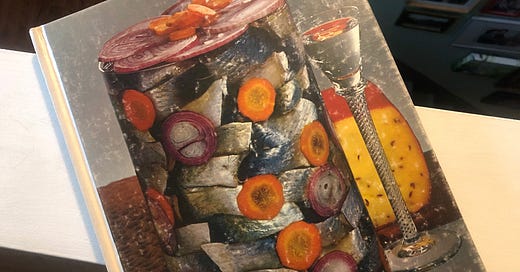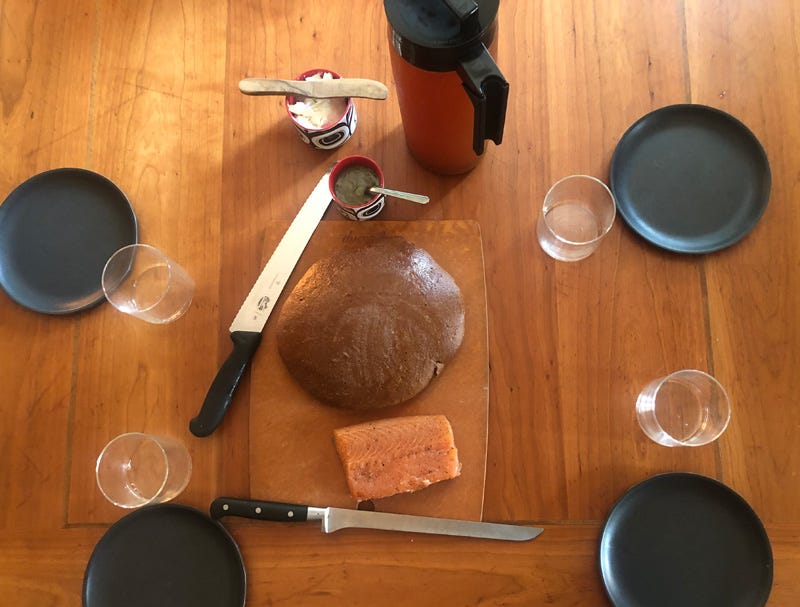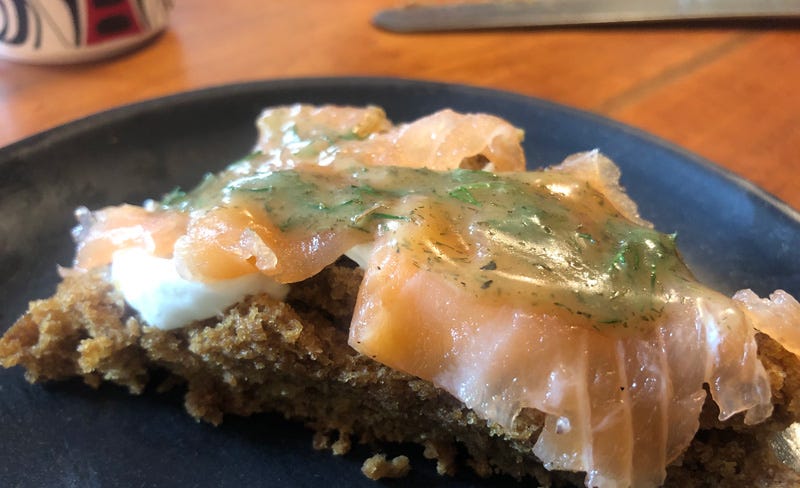The Cookbook Test #0002: ‘THE COOKING OF SCANDINAVIA’ BY DALE BROWN
INSTALLMENT #0002 (FREE) / ON WRITING A BOOK / THE COOKING OF SCANDINAVIA: GRAVLAX WITH MUSTARD SAUCE AND HÄTÄLEIPÄ, AQUAVIT, AND PYTT I PANNA
Dear Readers and Subscribers,
I owe you an apology, or at least an explanation, for today’s book. Generally speaking, my intention for THE COOKBOOK TEST is to discover new books alongside you, challenging my own preconceived notions and expanding my knowledge as we go.
But for today’s book, THE COOKING OF SCANDINAVIA, I’m going with an old favorite. When I think of a “vintage” cookbook, this is the one that comes to mind. It was written seven years before I was born, and it depicts an older, slower, more easy-going world. My mom’s mom had roots in Trondheim, Norway, and my wife’s family has ancestors in Denmark and Norway as well, so there’s something about this stuff that tastes like home.
I also want to talk about this book because it really feels like a proper book. The author (Dale Brown) traveled to write it - he traveled quite a lot, in fact. He talked to many people, rode many types of transportation, and tasted hundreds if not thousands of dishes to create this text. The photographer (Richard Meek) worked hard to create its illustrations - there are beautifully staged presentations, candid outdoor shots, portraits, photo-illustrations, even a recipe illustrated by sawing the side off of a saute pan so that the camera could effortlessly capture the sizzling happening within.
And you can tell from the book’s credits and from the overall production values that there was a team behind this text, too. Proper content editors, copy editors, photo editors. People to help coordinate travel, to organize its layout, to consult on the finer points of the cultures being explored. So many modern food or travel books are a matter of a publisher throwing $10-20,000 at an author and saying “good luck!” and then printing whatever happens next. The Cooking of Scandinavia - and, really, all the books in the Time-Life Foods of the World series - is a team effort, and the team is world-class.
The first recipe I’m exploring this week, the gravlax with mustard sauce and hätäleipä, is one that is a go-to in our household. To me, it tastes like home, and I love the experience of making gravlax for a fraction of the price of buying tiny little packages of pre-sliced stuff at the store. And when the weather gets cold here in Minnesota, you’ll find me making my own aquavit for for the winter months. It’s a great digestif and you can use it to make gravlax, too.
The final recipe, Pytt i Panna, is a new one for me, and I’m excited to share it with you.
at your service,
James Norton
THE COOKING OF SCANDINAVIA | BY DALE BROWN WITH RICHARD MEEK
Time-Life Books / 206 pages / 1968
If you’re not familiar with the Time-Life Foods of the World series of books, you might consider getting acquainted. There are a lot of them (everything from Cooking of the Caribbean Islands to Russian Cooking to American Cooking: Creole and Acadian), they’re beautifully illustrated, and they’re Anthony Bourdain-esque in their ability to enrich all things culinary with history / literature / culture writ large.
You’re not just getting a fistful of recipes - you’re getting insight into regions, and countries, and languages. Not until I got Cooking of Vienna's Empire did I understand that not only does Austro-Hungarian cuisine completely rule, there’s a real dividing line between the urbane cosmopolitan Vienna-driven Austro stuff and the much more rural / homey / stick-to-your-ribsiness of the Hungarian stuff.
The Cooking of Scandinavia dedicates a generous chapter to each of the major Scandinavian countries (Norway, Sweden, Denmark, and Finland) and goes in deep on aquavit, the smorgasbord, baking, and Christmas food.
Like most of the Foods of the World books, The Cooking of Scandinavia takes many scenic diversions from its formal outline. There are incredible foodscapes (see above.) There’s a National Geographic-like exploration and documentation of a traditional Norwegian country wedding.
And there’s a really terrific bit where world-famous actor Max von Sydow teaches you how to properly skoal. I once used this technique, specifically remembered from this photo series, at a Danish American Center dinner and won plaudits for knowing what I was doing. Thanks, The Cooking of Scandinavia!
The book’s writing is clear, elegant, precise and efficient, all virtues. But it also has the capacity to occasionally stir the soul, as it does here:
The thread of hospitality in Scandinavia has never been broken, and it shows no signs of fraying. The conditions for entertaining were laid down by the god Odin, and his admonition to his people rings out in a poem called “Hávamál,” the Viking code: “Fire he needs who with frozen knees / Has come from the cold without / Food and clothes must the farer have / The man from the mountains come. / Water and towels and welcoming speech / Should he find who comes to the feast.” And it was long the custom for a Norwegian farm wife to hang under the roof of her storehouse a basket with folded flat bread, a butter box, and cured meat and sausages, with a white tablecloth draped over everything - just in case somebody dropped by.
This absolutely rules. I love it. I think the direct chain from the speech of the gods to making sure everybody’s got a beverage and access to the appetizer platter is both one of the silliest and one of the most profound things we’ve got going for us as a species.
RECIPE #1: GRAVLAX
I’ve so thoroughly internalized this recipe that I’d forgotten that the original includes wrapping your salmon in aluminum foil and then smashing it with a weight throughout the curing process. I do neither of these things, and my gravlax comes out fine, so that’s a minor strike against the book. If you’ve got a nice watertight container (something Tupperware-like or the glass equivalent) just stack your fish so that it’s tightly pressed into the container and you’re golden. My version also includes a bit of alcohol, and the book’s doesn’t; I’ve made it both ways, and I prefer it made with gin or aquavit.
None of this changes the fact that the recipe is foundational for Scandinavian food, and that the version in The Cooking of Scandinavia is a good place to start.
Here’s my version of the recipe, which has never failed me. If you’re reading this newsletter in Minneapolis-St. Paul, I recommend getting your salmon at Coastal Seafoods, which is reliably excellent. If you’re somewhere else, go to your reliably excellent fish shop. If you don’t yet have one, now is a great time to locate one.
Keep in mind you can halve this recipe and it still works great - unless you’re hosting a big brunch, that’s not a terrible idea. Gravlax keeps for a while in the fridge, but not forever.
GRAVLAX
2-3 pounds of Atlantic salmon, cleaned, deboned, and scaled
1 large bunch of fresh dill (3-4 oz.)
1/4 cup coarse (Kosher) salt
1/4 cup brown sugar
2 Tbs. white or black peppercorns, crushed
1/2 oz. aquavit or gin
The ultimate goal of this recipe is to assemble a two-piece fish “sandwich” (skin down, flesh in, flesh in, skin up) smooshed into a tight container with dill and spices layered inside and outside of the sandwich.
In a small bowl, combine the salt, sugar, and crushed peppercorns.
Place 1/3rd of the dill in the bottom of a 2-3 inch deep glass, Tupperware, or enamel baking dish. Sprinkle 1/4 of the salt mixture on the dill. Place half of the salmon, skin side down, on the dill. Sprinkle 1/4 of the salt mixture on the fish.
Place 1/3 of the dill on the fish and sprinkle 1/4 of the salt mixture on the dill. Place the other half fish on top, skin side up, sprinkle the remaining salt and dill on top. Splash the whole package with aquavit or gin, cover the dish tightly, and refrigerate, turning every 12 hours for 36-48 hours.
When you’re ready to serve, scrape off all the dill and as much of the crushed pepper as you can (paper towels help). A bit of pepper won’t hurt. Thoroughly clean and dry your container before storing the gravlax in it, and refrigerate.
DILL MUSTARD SAUCE
Somewhere along the way - I think it was via Kirsten Larsen’s Only One Slice : Danish Sandwiches : "Smorrebrod" book - I picked up this simple and delicious dill mustard sauce recipe. What does this have to do with gravlax? Give me a second…
4 Tbsp. Dijon mustard
1 tsp. dry powdered mustard
6 Tbsp. brown sugar
1 Tbsp. white vinegar
5 Tbsp. peanut oil
4 Tbsp. fresh dill, chopped
2 Tbsp. dry dill flakes
In a small deep bowl, mix the mustard, sugar, and vinegar to a paste. With a wire whisk, slowly beat in the oil until it forms an emulsion. Stir in the chopped dill and dill flakes. The sauce may be kept refrigerated for up to a week.
This sauce, rich in flavor and impact, is one of my favorite types of recipes - it takes a few minutes to whip up and it’s essentially foolproof. Once you’ve shopped it, you’re 90% of the way there.
OK. We’ve got Gravlax, and we’ve got dill-mustard sauce. Now we need some “emergency” rye bread. I have no memory of how this came into my life, but it’s part of the tradition now. As the name suggests, it’s wicked easy and pretty fast.
HÄTÄLEIPÄ (EMERGENCY) RYE BREAD
1 Tbsp / 1 package active dry yeast
1 Cup warm water
2 Tbsp molasses
1 Tbsp olive oil or melted butter
1 tsp salt
1/2 Cup rye flour (dark or light)
1 1/2 Cups wheat/bread flour
Melted butter to brush top of loaf
In a large bowl, dissolve yeast in warm water and add molasses. Let stand for 3-5 minutes, until foamy. Stir in oil/butter, salt, and rye flour. Stir bread flour and then beat 50 times.
Turn dough onto the sheet covered with baking paper, spreading it into a round shape (the dough is very loose and sticky) about 8 inches in diameter. Let it rise 30 – 60 minutes.
Preheat oven to 400. Bake for 20 minutes or until center of loaf springs back when touched. Brush the top with melted butter.
This sweet, fluffy, molasses-kissed rye bread is really perfect when it’s served hot, split horizontally, and then cut into wedges. Each wedge can then be topped with cream cheese, gravlax, and a splash of dill mustard sauce. Got some garden-fresh tomatoes laying about? Throw on a thin slice or two of those. This combination (with or without tomatoes) is obscenely tasty.
RECIPE #2: AQUAVIT
“You can make your own aquavit?” You can easily make your own aquavit. If the price difference between a good aquavit and a decent mid-shelf vodka is noticeable - and it almost always is - it pays to put in a bit of labor and spices and make your own house brand of this bold, bracing Scandinavian mainstay.
Like a lot of infused spirits, most of the work gets done fairly quickly, and I recommend trying your aquavit after two days of infusing your spices - in general, that flavor works for me and I strain and enjoy at that point. You can intensify things a little with a longer steep, but it’s a pretty sharply diminishing curve.
AQUAVIT
4 cups vodka (roughly 1 liter)
4 sprigs fresh dill
4 (2-inch) strips of lemon zest without pith
2 tsp caraway seeds
1 tsp fennel seeds
4 pods of star anise
Put vodka, dill, and lemon zest in glass jar, seal and shake, then steep for one day in cool, dark place. Remove and discard lemon zest and dill.
Add caraway seeds, star anise, and fennel seeds to infused vodka. Let step as briefly as two additional days or as long as two additional weeks to achieve desired flavor. Strain out spices.
RECIPE #3: PYTT I PANNA
The big question for me when I set out to make Pytt i Panna AKA Swedish Hash was this: Will it reheat well? Because any recipe that demands a pound of roast beef as a mere constituent ingredient damn well better offer some kind of re-use value. And then I made it (a 3/4ths sized batch based on the idea that my kids wouldn’t like it), the kids liked it, and everything got eaten on the first night. Oh well. For what it’s worth, this is a very delicious classic hash.
I tweaked the original recipe to reduce the number of potatoes and onions (by numbers, not by cup measures.) I can only assume that potatoes and onions used to be smaller, because two regular russets were plenty to yield the 4 cups called for here, and one onion chopped finely was plenty to complement the rest of the recipe.
The roast/boiled lamb or beef is nice and general as it should be - pretty much any leftovers would work in this context. I had a spare Costco ribeye in the freezer so I chucked it into a bag and gave it the ol’ sous vide treatment (rare) with some soy sauce, sliced garlic and pats of butter. That turned out to be a terrific way to prep uncooked beef for this recipe, the finished bits of steak were thoroughly cooked but not overcooked, and brought their own flavor to the party.
Because the ham and steak were already seasoned, it didn’t take a tremendous amount of salt and pepper to take the potatoes to a seasoning level that worked with the hash as a whole. If you use seasoned meats, be careful with your salt in particular.
The recipe is pretty straightforward:
Dice in ¼” cubes: 2-3 medium peeled potatoes (4 cups), 1 pound roast or boiled lamb or beef (2 cups), ½ pound smoked ham (1 cup).
2 Tbsp butter
2 Tbsp oil
1 medium yellow onion, finely chopped
1 Tbsp finely chopped parsley
Salt and pepper
4-6 fried eggs or 4-6 raw egg yolks
Keep your chopped potatoes in water to prevent discoloration. When ready to cook, melt the butter and oil over high heat in a stout, preferably non-stick skillet. When the foam subsides, add potatoes, lower heat to medium-low, and fry for 15-20 minutes. When they’re crisp and hopefully golden, remove them to drain on paper towels. You may have to do some scraping and flipping if they stick to the pan.
Add a bit more butter and oil and your onions; cook until soft and transparent but not brown, 3-5 minutes. Add the diced meats, raise the heat to medium, and saute for 8-10 minutes, turning the meat so it browns on all sides. Stir in the potatoes to heat them back up, sprinkle with parsley, add salt and pepper to taste.
Arrange your servings of hash on individual plates, and push an impression into the center with a spoon. Top with a fried egg or an egg yolk in half a shell so your guest can dump the yolk into the hot hash and mix it around.
THE VERDICT ON THE COOKING OF SCANDINAVIA
(***BUY IT*** / BORROW IT / BROWSE IT / SKIP IT / BURN IT)
I really am a sucker for books from this gorgeous old Time-Life series, so my advice to anyone who spots them anywhere (thankfully they seem to have printed quite a few, and they hold up well) is to buy buy buy. One of those rare books that’s as good a travelog and history book as it is a recipe book, and a lovely edition to own for the photos alone.
GO FORTH AND SEEK OUT ...
Three Days of the Condor. This Robert Redford spy thriller hits surprisingly hard - it opens with a remarkably brutal sequence that makes a bookish CIA analyst (played by Redford) the last survivor of his office. He’s out on his own, hunted by an assassin named Joubert (Max von Sydow), with only some random chick he’s essentially kidnapped to keep him company on the run. (Note: this specific part of the film did not age very well.) Von Sydow is absolutely terrific in a surprisingly nuanced role, which is pretty typical - the dude’s an incredible actor. For that matter, if you didn’t see him in The Seventh Seal, that’s a famously good but also surprisingly funny film that’s also worth the time.













